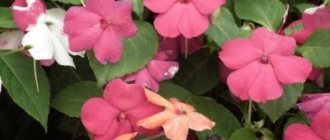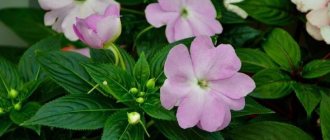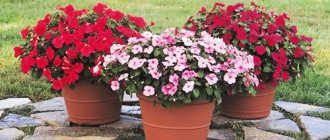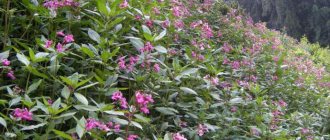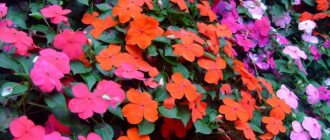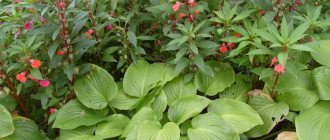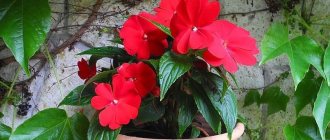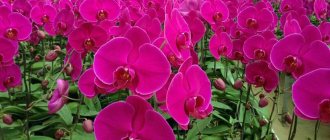New Guinea balsam is a relatively new species belonging to the genus Impatiens of the Balsamaceae family. This species was bred artificially by crossing Hawker's balsam and other valuable plant species. Representatives of the New Guinea species immediately gained great popularity, which only grows over the years. Thanks to their high decorative value, hybrids have confidently occupied their niche in indoor floriculture.
New Guinea balsam is unpretentious, so caring for the flower at home is not burdensome. Moreover, it does not have a pronounced dormant period, like most decorative flowering crops. Accordingly, caring for a flower does not imply strict adherence to the “winter” - “summer” regimes.
Botanical description and history
New Guinea hybrids first appeared on the flower market in 1972. They were bred by crossing the Indonesian variety Hawker with other types of balsam. New Guinea balsam is native to the subtropics and tropics of Africa, Asia and America.
Depending on the place of growth and variety, the flower grows from 30 to 50 cm. The root system is strong and grows well. The plant has the appearance of a bush with many stems .
For oblong-oval pointed leaves:
- bright veins;
- serrated edges;
- short petioles.
Flowers with curly petals can reach a size of 5-7 cm. Depending on the variety, they are one-color or two-color with patterns. At the top of the stems there is one or several buds. Flowering continues for several months, this is influenced by climatic conditions and place of growth.
In place of the flower, a fruit is formed - an oblong capsule . Its outer part is divided by ribs. Once the fruit is ripe, it opens when touched, releasing the seeds. In nature, a flower reproduces this way.
New Guinea hybrids and the simple reason for their growing popularity
Among all the varieties, groups of varieties and even types of balsams (Impatiens), the so-called hybrid varieties of the Nuova Guinea group or New Guinea hybrids (often labeled as New Guinea Impatiens) are today considered the best, although some time ago these plants were considered one of the most capricious and exclusively "Western".
The change in status and growing popularity of New Guinea impatiens has a simple explanation: these plants boast a unique ability to bloom all year round. And although in regions with harsh winters they are grown only as seasonal plants in the garden, they have no equal in indoor culture. The unique duration of flowering can be appreciated even in the middle zone.
The two main features of New Guinea hybrids are meatiness and power. They have strong shoots, very densely spaced bright dark green leaves and pretty bright asymmetrical flowers, as if evenly scattered throughout the bush. The beauty of both greenery and flowering sets them apart from more than half a thousand species and many thousands of varieties of balsams. And it seems inappropriate to assign popular nicknames to this plant - light, Vanka wet, touchy. Although the main feature of balsams - scattering of seeds, cracking of the capsule at the slightest touch - is also preserved by the New Guineans.
New Guinea hybrids first appeared on the flower market in 1972, and the group of these hybrids can be called relatively young. It is believed that they were bred by crossing the Indonesian Impatiens Hawker with other species. These plants, up to 20-30 cm high, can be considered both indoor and garden varieties, but they fully display their talents indoors. In fact, these are universal varieties that can be used at your discretion. They have very compact, dense bushes and much stronger shoots that are more resistant to injury than ordinary impatiens.
The leaves are dense, broadly lanceolate, sit on short petioles in whorls, decorated with a finely serrated edge; in some varieties they can reach 10 cm in length. “Recessed” veins are clearly visible on the leaf blades. And the flowers are much fleshier, larger, up to 5-8 cm in diameter, with graceful petals and a small colored eye. Flowers bloom in axillary “bundles” or one at a time. In garden culture, New Guinea balsams bloom only in the spring, but when grown indoors, they bloom all year round.
New Guinea hybrids also appreciate the color range - pure pastel or watercolor shades and rare variations of pink shades, fuchsia, candy, salmon, peach, apricot tones. The color of the leaves is also very variable: in addition to intense dark green, different varieties also have brighter variations and original shades - bronze or with a yellowish highlight in the center of the leaf blades.
The variety of New Guinea hybrids allows you to choose both more compact and larger plants, very different from the more familiar Waller's balsam. Actually, according to size, they are divided into three groups - compact (up to 20 cm), spreading and tall (up to 60-90 cm) varieties.
In New Guinea hybrids, it is most often not individual varieties that are distinguished, but entire series of varieties. The best of them include:
- "Macarena" with bronze leaves and orange flowers;
- 'Jangle Rain' - impatiens with pastel, soft colors and glossy dark leaves;
- 'Harmony' is a variety series with densely branching compact bushes, bright red, bronze or green foliage and almost round, dense flowers;
- 'Rainforest Exotic' - balsams, whose bright “tropical” colors in single and two-color variations go well with dark leaves;
- "Java" is a series of plants with bright orange-pink-red "acrylic" tones and green or bronze leaves;
- “Mini Gini” is a small-flowered series, the plants of which have dark bushes strewn with hundreds of small flowers;
- “Divaro” is a series of compact, densely branched balsams with bright green leaves and medium-sized, neat flowers;
- 'Spreading White' is a variegated New Guinea with snow-white flowers.
In growing New Guinea balsam hybrids, the most important thing is to choose the right conditions and choose the plant itself with all the attention to the “details”. New Guineans can be found on sale mainly in the spring
But many flower balsams are delivered by autumn. When purchasing bushes, you should carefully inspect them, noting the slightest signs of disease or pest damage: if you miss even a speck, the plant will not be cured and you will most likely just have to throw it away.
Description of appearance and features
At home, New Guinea balsam can bloom for 10 months. Among gardeners, this property makes the plant very popular.
New Guinea hybrids are distinguished by their power and meatiness . They have strong shoots, bright asymmetrical flowers and very densely spaced leaves. Of the numerous varieties of balsams, these stand out for the beauty of their blooms and the richness of their greenery.
The peculiarities of varietal New Guinea balsam include the fact that the plant sheds its leaves due to:
- hypothermia;
- lack of lighting;
- drying out of the soil.
How the flower will bloom is influenced by the choice of pot, as well as the systematic introduction and composition of fertilizers.
New Guinea hybrids are valued for their colors . Flowers come in different shades:
- pink;
- apricot;
- peach;
- pastel;
- fuchsia, etc.
In addition to the bright dark green color, the leaves are bronze or have a yellowish discoloration in the middle.
Application in design
The flower is distinguished by its exquisite appearance, which will become a wonderful decoration for your home interior.
New Guinea balsam is often planted in hanging baskets and small planters.
By growing New Guinea balsam in the garden, you can create unique flower beds and decorate garden paths with it. It is also well suited for decorating recreation areas and terraces.
Photo
Next in the photo you can look at the plant and admire the beauty of its flowering.
There are more than 400 types of balsam in nature, but in the Northern Hemisphere the following varieties are common: Garden, Wild, Zheleznokosny or Zhelezisty, Tom Samb, as well as Waller's balsam. Flower growers love to grow double and hanging plant species - they will decorate any area or apartment.
Problems in growing New Guinea balsams
In their tendency to spread root rot, New Guineans are no different from other balsams. But the risk of damage only occurs as a result of improper watering. But pests, especially thrips and red spider mites, can appear on the plant both in the vicinity of infected plants and in the fresh air in the heat. It is very difficult to fight them; they quickly lead to damage to the appearance of leaves and flowers. It is believed that it is easier to throw away balsam than to fight insects.
Landing
Can the plant be planted in the garden?
New Guinea balsam is one of the easiest plants to care for , both on the windowsill in the apartment and in the garden. It can withstand short drying and waterlogging of the soil.
Important! It must be borne in mind that in this case the decorative effect of the flower, the density of the leaves and the number of developing buds suffer.
Lighting and location
New Guinea balsam prefers soft, diffused light . It should not be exposed to direct sunlight. The best location for the flower is the window sills facing west and east. In winter, when daylight hours become shorter, the plant requires additional lighting. Otherwise, its shoots will stretch out and the leaves will begin to fall off.
Soil requirements
The flower grows well in light, fertile soil. You can purchase a ready-made substrate or prepare it yourself by mixing:
- Fertile soil.
- Leafy soil.
- Peat.
- Humus.
- Sand.
The self-prepared mixture must be disinfected.
Methods of propagation of New Guinea balsams
New Guinea balsams can be propagated both by seeds and vegetatively.
The simplest and easiest method is cuttings. For rooting, choose strong young shoot tips with 2–3 pairs of leaves (more precisely, three internodes). The lower pair of leaves is removed, and the cuttings are treated with growth accelerators if desired. You can root balsam branches in a light substrate or water. Usually the whole process takes 1-2 weeks.
For flowering by the end of spring and beginning of summer, seeds should be sown very early, in January-February. Due to the need for additional lighting and careful control of air humidity, it is believed that New Guinea balsams are easier to buy “ready” than to grow from seeds yourself.
Flower care at home
How to care for a flower?
For normal growth at home, indoor New Guinea balsam requires certain care. The temperature should be 18°C…24°C . The flower has a negative effect:
- temperature below 10 °C;
- frosty air;
- drafts.
Therefore, it should not be placed on the windowsill in the kitchen, because there the windows are often opened for ventilation.
The plant needs to be watered regularly, abundantly, but only after the top layer of soil has dried. This will prevent rot from appearing. In winter, watering is reduced to twice a month , the water flowing into the pan should be poured out.
These plants come from the tropics with high humidity, so when the air is dry they can drop buds and flowers.
Regular spraying will help create optimal humidity in the room, with the exception of flowers and buds.
This procedure is especially necessary in extreme heat and with the onset of the heating season. The leaves of the flower can be wiped with a damp sponge, thereby removing the layer of dust and allowing them to breathe freely.
Abundant flowering is impossible without feeding. Twice a month, New Guinea balsam is fertilized with mineral compounds with potassium. This element contributes to the formation of flowers. There is no need to feed with pure nitrogen, due to which the green mass will actively grow and flowering will slow down.
New Guinea balsam does not tolerate pruning . If you want the bushes to look denser and more compact, you can pinch the tops of the shoots. Although the plant itself is able to form a magnificent shape. To create the appearance and shape of the bush, pruning of only the Harmony type is allowed.
The flower must be replanted once every 2-3 years. This is done in the spring. You need to take a small pot, both in diameter and depth. In cramped conditions, New Guinea balsam will grow more luxuriantly. At the bottom, arrange a drainage layer, for example, from expanded clay. The flower must be carefully transferred from pot to pot. Fill the resulting void with soil to such a level that the root neck rises 2 cm above it.
What to do with a flower in winter
Waller's balsam - cultivation and care
For 2-3 cold months, dormant conditions are created for Impatiens neuguinea: the ambient temperature is reduced to 12 °C, the intensity of lighting and watering is reduced. In winter, flowers are not placed near heating devices or in drafts.
The dormant period is a very good time to prune flowers. This will make it possible to propagate hybrids by rooting cut stems. In addition, plants are cut from spring and summer, but in this case, pruning can cause the impatiens to shed flower ovaries.
Common diseases and pests
In most cases, New Guinea balsam gets sick from improper care. This is evidenced by the external state of its parts. When exposed to direct sunlight, yellow spots appear on the leaves. This means that the flower has received burns.
It happens that when the heating is turned on, balsam leaves begin to :
- let the edges dry;
- wither;
- fall off
You need to install special trays with water and expanded clay or install a humidifier. If the always colorful leaves turn pale, this indicates a lack of nutrients. The application of complex fertilizers will help them become bright again.
The following leads to rotting of the root system and stems of New Guinea balsam, and subsequently to fungal diseases:
- excessive watering;
- soil waterlogging;
- too damp air.
The flower can suffer from insect pests: aphids and spider mites. Infected New Guinea balsam must be isolated. Treatment is carried out with special drugs. They treat the flower itself and the ground.
Garden and indoor balsam, homeland of the plant, photo, video
The genus Impatiens, which can be translated as “untouchable” or “touchy,” is the basis of the Impatiens family and consists of half a thousand species growing throughout the planet.
Due to the prevalence and diversity of plants, it is impossible to indicate the exact place on the map worthy of being called the birthplace of balsam plants. They are found throughout the world in temperate and tropical regions, but there are several main concentration centers for the species. These are, first of all, Asia and African countries, North America and Europe.
History of the discovery and study of balsams
The acquaintance of botanists with impatiens began in the 17th century. The first information about plants of this genus dates back to 1689 and contains descriptions of some varieties of balsam from India and nearby regions of Asia. Then Carl Linnaeus began studying plants; flower growers owe him the most complete description and systematization of numerous species. But scientists expected the greatest number of discoveries in the world of balsams in the 19th century, when remote corners and countries began to be actively explored. One of the latest additions was a group of New Zealand plants registered in 1989.
The most famous species in our country is Waller's balsam, which grows wild off the east coast of Africa in the Zanzibar archipelago.
It was here that plants new to botanists were discovered in 1861. Several specimens, originally named after a local ruler, were transported to Europe by the British naturalist John Kirk. Here, the attentiveness of the English missionary Horace Waller, who first noticed an unknown plant, and his discovery were appreciated. And the African impatiens received the name Impatiens walleriana in 1896.
The plant is loved by residents of many countries. Today, the continuously blooming indoor balsam is often called Busy Lizzie in the West, and in Russia the culture is called the light Vanka Mokry. Such an unusual, even familiar name is explained by the peculiarity of the plant, which forms small droplets of sweet liquid on the leaves, which over time turn into hard sugar balls.
Among the garden balsams, in the photo, Impatiens balsamina stands out - a small but very attractive native of South Asia, decorating flower beds and borders in many regions of Russia.
In the 20th century, flower growers were able to get acquainted with a large group of hybrids from New Guinea. Now these exotic plants are available to collectors and lovers of indoor plants, and some varieties in mid-latitudes have become so comfortable that they have become real weeds, displacing native species from their usual places.
This fully applies to Himalayan balsam, which a hundred years ago was found only in its homeland.
What does balsam look like?
Among the impatiens or, as they are usually called in Russia, balsams, there are wild, garden and domestic crops. Annual plants in the middle zone are grown as garden balsams, and indoor varieties are crops whose growing season lasts several years.
Thanks to the active breeding work that began in the middle of the last century and the popularization of unpretentious, readily flowering species, balsams have taken their rightful place in the collections of flower growers.
Moreover, they differ so much from each other in the shape and color of flowers, size and habitat that it is difficult to even suspect representatives of different species of belonging to the same genus. Among the balsams there are:
- herbaceous annual plants and perennial varieties that look like small trees or shrubs;
- dwarfs no higher than 20 cm and giants 2 meters high;
- frost-resistant species accustomed to living only in warm tropical climates.
Therefore, the answer to the question: “What do balsams look like?” cannot be simple and monosyllabic.
But with a lot of differences, balsams from different parts of the world also have a lot in common. Plants are called touch-me-nots because of the peculiarity inherent in many varieties. The slightest touch to the juicy fruit-box causes it to instantly open, and the contents scatter with great force over a distance of several meters.
In the plant world, balsams are considered unique record holders for the variety of shapes and colors of corollas.
The flowers of indoor balsam and its garden counterparts can be simple or double, monochromatic or two-color, with a bright contrasting center or a scattering of spots on the petals.
The average diameter of an indoor balsam flower is 2–4 cm, but there are also plants that delight owners with larger, brightly colored corollas. A characteristic feature of the balsam flower is a thin curved spur, but the shape and size of the petals can vary:
- Indoor Waller's balsam has flattened corollas, and the petals that make them up are almost identical.
- In other varieties, due to the shortened asymmetrical petals, the flowers are more reminiscent of violets or snapdragons.
This diversity is associated with different living conditions of plants and which insects participate in pollination.
Features of balsam plants
The vast majority of indoor and garden balsams love shade; there are few exceptions to this rule. First of all, these are plants from New Guinea and, for example, wild balsam glandulifera. But moisture is vital for all impatiens, but moisture-loving species have to protect flowers and leaves from excess water.
The smooth lanceolate leaves of balsams are not distinguished by a variety of shapes, but can have either a single or variegated color. Interestingly, thanks to the special coating on the surface of the sheet plate, drops roll off it, and the sheet remains dry even in heavy rain. The underside is protected from getting wet and rotting by a mass of tiny air bubbles trapped between the fibers.
The flowers are protected from dew and rain by the pedicels that lengthen as the corolla opens. As a result, the garden balsam flower, as in the photo, bends over, and streams of water cannot wash away the ripe pollen.
Video about balsam and its types
www.glav-dacha.ru
Features of reproduction
Under natural conditions, balsam propagation occurs using seeds. It is difficult to grow a flower at home this way.
Seeds
According to statistics, out of 10 sown seeds, only 5 germinate. You must also keep in mind that young plants obtained from seeds develop slowly ; the slightest reason can lead to their death.
First you need to prepare fertile soil on which to carefully spread the seeds. After this, sprinkle them with a small layer of earth. Then moisten using a spray bottle or watering can with a spray bottle.
All this must be covered with a transparent film or glass to create a greenhouse effect. It is necessary to systematically open the container to ventilate and moisten the soil, preventing the earthen clod from drying out. The appearance of the first shoots can be expected in 1.5-2 weeks.
Cuttings
The most effective method of propagating New Guinea balsam is cuttings. To do this, below the node, you need to cut off the stalk on which you want to remove the lower leaves. Plant it in prepared soil. It is necessary to place the cutting in a warm place where there is no draft and where direct sunlight does not penetrate. Roots form after 14 days .
In indoor conditions, New Guinea balsam lives for 4-5 years, then it needs to be renewed. When grown in open ground, the plant becomes an annual.
Impatiens is a flower that, although it does not smell, stands out for its magnificent blooms. It is widely used in landscaping personal plots. With the help of New Guinea balsam flowers of different colors, landscape designers create picturesque and unique compositions.
Replanting New Guinea balsams, soil and rejuvenation
The substrate for hybrid balsams of the New Guinea group is selected from among loose, permeable and necessarily light soil mixtures. Optimal pH values are from 5.8 to 6.2. For balsams, you can use universal substrates, to which it is better to add loosening components.
Indoor New Guinea balsams do not have to be thrown away after flowering has finished: they are a perennial crop that can bloom tirelessly for up to 3 years or more. They bloom tirelessly and remain decorative for a long time, so if in the spring your plant is still attractive, you can transplant it into a new container (if the soil is not completely developed, the roots have room to develop, then you don’t need to replant, but simply replace the top layer of the substrate). When grown in the garden or in balcony boxes, plants also do not have to be doomed to death: at the end of summer they can be transplanted into pots and transferred to indoor culture.
Pots for New Guinea balsams are increased slightly: it will be difficult to achieve abundant flowering in containers that are too spacious.
In order to achieve maximum decorative value from New Guinea balsams, it is better to plant several plants in one pot (usually up to 3-5 plants are sold in one container). When planting, the root collar should remain flush with the soil or located slightly higher. When planted in soil, balcony boxes or flower beds, impatiens welcome soil mulching with compost or peat. The planting distance should be about 30-40 cm. It is advisable to lay a high layer of drainage at the bottom of any containers.
New Guinea balsams are capable of maintaining profuse colors and attractiveness for up to 3 years, after which the plant will have to be replaced with new specimens. True, such a rapid loss of decorativeness is typical only with continuous year-round flowering.
New Guinea balsams
Why does balsam drop its leaves and dry out?
The reason why a flower drops its leaves and dries out may be improper care or damage by diseases and pests. It should be noted that all balsam diseases, including pest infestation, are also the result of improper care.
If the balsam has dropped its leaves, the following care points should be analyzed:
- Air temperature and humidity. Perhaps the room is too hot or the air is too dry.
- Lighting. Leaves may droop due to lack of light.
- Fertilizers. Improperly organized feeding can seriously harm the plant.
- Pot. Balsam is comfortable only in tight spaces.
If all of the above reasons are excluded, most likely the flower is seriously ill or has become a victim of pests.
Diseases and treatment
Most often, balsam is affected by rot:
| Type of rot | Symptoms | Treatment methods |
| Root | Drying of leaves and buds, stunting of growth | Treatment is effective only in the early stages of the disease. The affected parts of the plant are cut off and destroyed. The flower is treated with a fungicide. The pot and used tools are disinfected. The soil is replaced with fresh |
| Stem | Withering of flowers and appearance of brown spots on leaves. Over time, a gray edge appears on the spots | |
| Gray | Rotting of the stem and petioles | |
| Black | Blackening and slimy coating on the basal part of the stem, growth arrest |
All types of rot are caused by fungal infections and are very dangerous for the plant. Impatiens with advanced stages of rot development die.
How to collect seeds
Procedure:
- first option. Take a small bag, bring it to the box, squeeze the achene so that the oval elements pour into the container;
- second option. Pick the seeds together with the capsule. It is important to act carefully, otherwise the contents of the achene will crumble. Carefully squeeze the box between your fingers, tear it off, rub the dried base, scatter the seeds on a sheet of paper to dry.
The finished seed is stored in small paper bags in the absence of dampness. Shelf life with preservation of germination is 8 years.
The Vanka wet flower or garden balsam is an effective decorative element for a summer cottage. The variety of varieties allows you to choose the optimal variety of tropical plant without hassle. The flower is quite unpretentious, but requires precise implementation of basic agrotechnical measures.
Video - characteristics of garden balsam and useful recommendations for gardeners about the secrets of growing plants on the site:
Flowering and what to do after flowering
Important details:
- Impatiens produce buds and delight the eye with spectacular colors for several months. There is no specific flowering period; the timing depends on the variety and variety of garden plant.
- At high temperatures, dry soil and air, the buds fall off.
- Fertilizing is not carried out during flowering; potassium fertilizers are applied during the period of bud release.
- If there is not enough space in the pot or a lack of nutrients, the plant blooms poorly.
- Buds and leaves fall off after cold rain or sudden temperature changes, or frosts.
- Poor lighting, low temperatures, short daylight hours are factors that interfere with the flowering of balsam, especially in winter.

